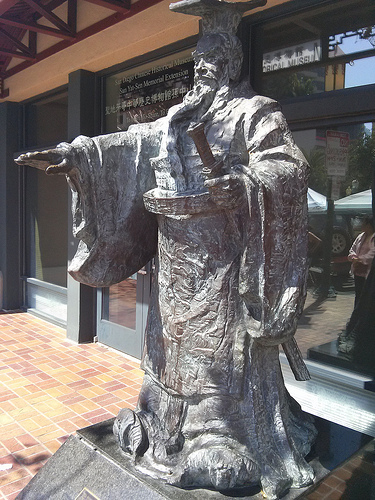- Born: 259 BCE
- Died: 210 BCE
- Reign: 247-210 BCE
- Chinese/Japanese: 秦始皇帝 (Qín shǐ huáng dì / shin shi koutei)
Qín shǐhuángdì (lit. "first emperor of Qin") is regarded as the first emperor of China, having ended the Warring States Period by uniting central China under his State of Qin. He is known for a number of famous accomplishments, including the construction of the Great Wall, a national road system, and a great tomb for himself guarded by a massive Terracotta Army. He is also infamous for his tyrannical rule, and in particular policies of burning books and burying scholars.
There are a number of theories as to the emperor's lineage, with some saying he was the son of powerful merchant Lü Buwei, and others that his father was King Zhuangxiang of Qin, also known as Yiren. In either case, according to one version of his biography, the man who would grow up to become emperor was born to a concubine of Lü Buwei's, at a time when King Zhuangxiang was Lü's prisoner. The boy was born in Handan, capital of the State of Zhao, and became King of Qin in 247 BCE at age 13, upon the death of King Zhuangxiang.
The young king entrusted affairs of state to Lü Buwei for a time, but after Lü was implicated in a plot against the throne c. 238 BCE, the king instead turned to the Legalist Li Si to advise him.
Defeating all his neighbors and rivals, and surviving a famous assassination attempt in 227 BCE at the hands of Jing Ke[1] the king united all of central China under his rule in 221 BCE. He would reign as "emperor" for only about ten years, but during this brief reign, he established standardized systems of weights & measures, language, and currency, as well as the geographical/political divisions of provinces and counties, and established a standard ideological or intellectual tradition through the practice of "burning books and burying scholars" - in other words, destroying those traditions, and their supporters, of which he disapproved.
Following his death in 210 BCE, the emperor was succeeded by his son, most commonly known today simply as Qin Er Shi (Qin second generation [emperor]). He was buried in a massive, elaborate tomb outside Xi'an, which today remains largely un-excavated. It is said to contain great treasures, and a scale model (map) of the entire realm, with liquid mercury used for the rivers and lakes. The tomb, supposedly, is also equipped with ever-burning torches and numerous booby traps, though much about the tomb is likely purely legend. However, the massive Terracotta Army constructed to guard the tomb has been discovered, and largely excavated, and remains one of the most famous archaeological discoveries in the world.
| Preceded by King Zhuangxiang of Qin |
King/Emperor of Qin 247 - 210 BCE |
Succeeded by Qin Er Shi |
References
- "Shikôtei," Sekai dai hyakka jiten 世界大百科事典, Hitachi Solutions Business, 2013.
- "Shikôtei," Digital Daijisen デジタル大辞泉, Shôgakukan.
- ↑ This assassination attempt forms the core of the plot of the Jet Li film Hero.
